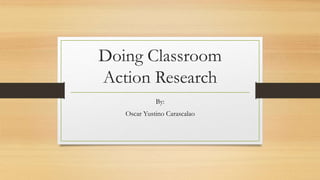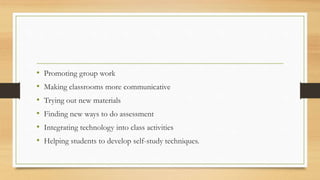This document provides an overview of action research and the steps involved in conducting action research as a teacher. It discusses that action research involves teachers taking a self-reflective, critical and systematic approach to exploring their own teaching contexts. The key steps outlined are planning, action, observation, and reflection. Planning involves identifying an area of focus, developing research questions, and preparing materials. During the action stage, teachers collect and analyze both qualitative and quantitative data. Observation methods include checklists, notes, recordings and photographs. Non-observation methods include interviews, questionnaires, journals and reviewing documents. Reflection involves analyzing and interpreting the data, assessing outcomes, and planning next steps to improve teaching practice.

















![Developing and refining your questions
There are several other techniques that can be used to help shape your thinking and focus your
questions:
• Focusing circles: This is a technique from Edge (1992, pp. 37–38) through which you can narrow
your focus by drawing a small circle at the center (inside) of a larger one. The issue, topic or
problem is written in the small circle and the larger [circle] is divided into four segments. In each
of these segments an aspect of the topic is written. One of these four segments then becomes
the center of the next circle and so on.
• Mind maps: Most teachers have, at some time, used mind maps or spider webs. Probably the
most comprehensive guide to the use of mind mapping is provided by Buzan & Buzan (1996).
Here the issue is written at the center of a piece of paper and related factors branch out from the
center.](https://image.slidesharecdn.com/car-150319231854-conversion-gate01/85/Classroom-Action-Research-18-320.jpg)








































